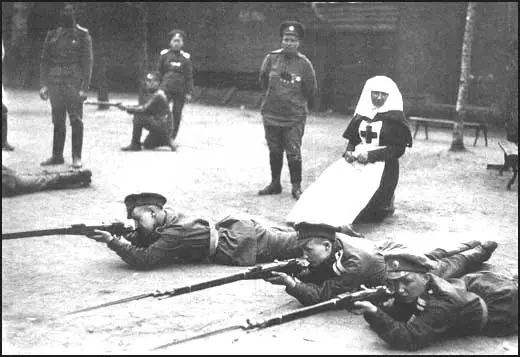Maria Bochkareva
Maria Bochkareva, the third daughter of a peasant family, was born in Novgorod Oblast in 1889. Badly beaten by her alcoholic father, she left home at fifteen to marry Afansi Bochkareva. The couple moved to Tomsk, Siberia where they worked as labourers on a construction site. A good organiser, Maria eventually became foreman of a team of 25 male workers.
Physically abused by her husband, Maria left him and found work on a steamship. Later she married a second man, Yakov Buk, but he was also violent towards her and and in 1914 she left him and joined the 25th Reserve Battalion of the Russian Army. Although the men laughed at having a woman in their regiment, she soon gained their respect in battle. She admitted in her autobiography: "The news of a woman recruit had preceded me at the barracks and my arrival there precipitated a riot of fun. The men assumed that I was a loose-moraled woman who had made her way into the ranks for the sake of carrying on her illicit trade."
Over the next three years Maria was wounded twice and decorated three times for bravery. Florence Farmborough, a nurse working in Russia, recorded in her diary: "Maria Bochkareva... a Siberian woman soldier had served in the Russian Army since 1915 side by side with her husband; when he had been killed, she continued to fight. She had been wounded twice and three times decorated for valour."
In May 1917, Maria persuaded Alexander Kerensky, the country's new leader, to allow her to form a Women's Battalion. In a speech given in June, she argued: "Come with us in the name of your fallen heroes. Come with us to dry the tears and heal the wounds of Russia. Protect her with yours lives. We women are turning into tigresses to protect our children from a shameful yoke - to protect the freedom of our country."

Maria Bochkareva managed to persuade over 2,000 women to join the Women's Battalion. The American journalist, Bessie Beatty, went to see the women on the Eastern Front: She wrote: "Women can fight. Women have the courage, the endurance and even the strength for fighting. The Russians have demonstrated that and, if necessary, all the other women in the world can demonstrate it."
Florence Farmborough commented on 13th August, 1917: "At dinner we heard more of the Women's Death Battalion. It was true; Bochkareva had brought her small battalion down south of the Austrian Front, and they had manned part of the trenches which had been abandoned by the Russian Infantry. The size of the Battalion had considerably decreased since the first weeks of recruitment, when some 2000 women and girls had rallied to the call of their leader. Many of them, painted and powdered, had joined the Battalion as an exciting and romantic adventure; she loudly condemned their behaviour and demanded iron discipline. Gradually the patriotic enthusiasm had spent itself; the 2000 slowly dwindled to 250. In honour to those women volunteers, it was recorded that they did go into the attack; they did go 'over the top'. But not all of them. Some remained in the trenches, fainting and hysterical; others ran or crawled back to the rear."
On 25th October, Bochkareva and the few remaining members of the Women's Battalion attempted to defend the Winter Palace against Bolshevik forces. John Reed, an American journalist in Petrograd during the revolution reported that "all sorts of sensational stories were published in the anti-Bolshevik press, and told in the City Duma, about the fate of the Women's Battalion defending the Palace. It was said that some of the girl-soldiers had been thrown from the windows into the street, most of the rest had been violated, and many had committed suicide as a result of the horrors they had gone through."
Alfred Knox, the British Military Attaché in Petrograd, intervened in order to help free members of the Women's Battalion who had been captured during the attack on the Winter Palace. This involved him negotiating with Vladimir Antonov-Ovseenko: "I borrowed the Ambassador's car and drove to the Bolshevik headquarters at the Smolny Institute. This big building, formerly a school for the daughters of the nobility, is now thick with the dirt of revolution. Sentries and others tried to put me off, but I at length penetrated to the third floor, where I saw the Secretary of the Military-Revolutionary Committee (Vladimir Antonov-Ovseenko) and demanded that the women should be set free at once. He tried to procrastinate, but I told him that if they were not liberated at once I would set the opinion of the civilized world against the Bolsheviks."
The Duma appointed a commission to investigate the claims of ill-treatment and on 16th November, Dr Mandelbaum, reported that three had been violated, and that one had committed suicide. However, he claimed that none had been "thrown out of the windows of the Winter Palace." On 21st November, 1917, the Bolshevik Military Revolutionary Committee officially dissolved the Women's Battalion.
After her release Maria Bochkareva fled to the United States. Funded by Florence Harriman she lived in San Francisco before travelling to New York City and Washington to meet leading politicians. This included President Woodrow Wilson, who promised to do all he could to defeat the Bolshevik government. While in America, Bochkareva dictated her memoirs, Yashka, My Life as Peasant, Exile and Soldier to Isaac Don Levine.
Bochkareva travelled to London where she was granted an audience with King George V. She also met members of the British government and it was agreed to pay for her to return to the White Army controlled Russia. Attempts to form another Women's Battalion ended in failure. In April 1919 she moved to Tomsk and served under Alexander Kolchak. Later that year she was captured by troops led by Nestor Makhno and Mikhail Frunze.
Maria Bochkareva was sent to Krasnoiarsk where she was interrogated by the Bolsheveks. She was execution by firing squad on 16th May, 1920.
Primary Sources
(1) In her book Yashka, My Life as Peasant, Exile and Soldier, Yasha Bochkareva described how she was received when she joined the Russian Army.
The news of a woman recruit had preceded me at the barracks and my arrival there precipitated a riot of fun. The men assumed that I was a loose-moraled woman who had made her way into the ranks for the sake of carrying on her illicit trade.
(2) At first Yasha Bochkareva had problems with her male colleagues at night in the barracks.
As soon as I made an effort to shut my eyes I would discover the arm of my neighbour on the left around my neck, and would restore it to its owner with a crash. Watchful of his movements I offered an opportunity for my neighbour on the right to get too near me, and I would savagely kick him in the side. All night long my nerves were taut and my fists busy.
(3) Speech made by Yasha Bochkareva on the steps of St. Isaac's Cathedral in Petrograd in June 1917.
Come with us in the name of your fallen heroes. Come with us to dry the tears and heal the wounds of Russia. Protect her with yours lives. We women are turning into tigresses to protect our children from a shameful yoke - to protect the freedom of our country.
(4) Bessie Beatty, a journalist from San Francisco, spent several days with the Women's Death Battalion. She wrote about it in her book The Red Heart of Russia, that was published in 1918.
Women can fight. Women have the courage, the endurance and even the strength for fighting. The Russians have demonstrated that and, if necessary, all the other women in the world can demonstrate it.
(5) In her diary, Florence Farmborough records hearing about Yasha Bochkareva, the founder of the Women's Death Battalion.
26th July, 1917: Yasha Bochkareva, a Siberian woman soldier had served in the Russian Army since 1915 side by side with her husband; when he had been killed, she continued to fight. She had been wounded twice and three times decorated for valour. When she knew the soldiers were deserting in large numbers, she made her way to Moscow and Petrograd to start recruiting for a Woman's Battalion. It is reported that she had said, "If the men refuse to fight for their country, we will show them what the women can do!" So this woman warrior, Yasha Bochkareva, began her campaign; it was said that it had met with singular success. Young women, some of aristocratic families, rallied to her side; they were given rifles and uniforms and drilled and marched vigorously. We Sisters were of course thrilled to the core.
9th August, 1917: Last Monday, an ambulance-van drove up with three wounded women soldiers. We were told that they belonged to the Bochkareva Women's Death Battalion. We had not heard the full name before, but we instantly guessed that it was the small army of women recruited in Russia by the Siberian women soldier, Yasha Bochkareva. Naturally we were all very impatient to have news of this remarkable battalion, but the women were sadly shocked and we refrained from questioning them until they had rested. The van driver was not very helpful but he did know that the battalion had been cut up by the enemy and had retreated.
13th August, 1917: At dinner we heard more of the Women's Death Battalion. It was true; Bochkareva had brought her small battalion down south of the Austrian Front, and they had manned part of the trenches which had been abandoned by the Russian Infantry. The size of the Battalion had considerably decreased since the first weeks of recruitment, when some 2000 women and girls had rallied to the call of their leader. Many of them, painted and powdered, had joined the Battalion as an exciting and romantic adventure; she loudly condemned their behaviour and demanded iron discipline. Gradually the patriotic enthusiasm had spent itself; the 2000 slowly dwindled to 250. In honour to those women volunteers, it was recorded that they did go into the attack; they did go "over the top". But not all of them. Some remained in the trenches, fainting and hysterical; others ran or crawled back to the rear.

